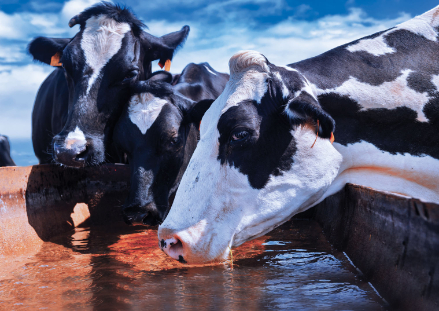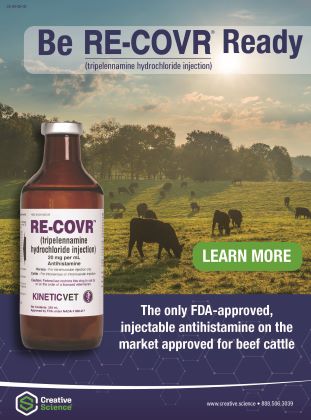Don’t Overlook Water in the Winter

Don’t Overlook Water in the Winter
Winter marks a time of uncertainty and, especially for cattle operations in harsh climates or otherwise remote regions with limited resources. While some of the most common concerns are accessibility through snow and ice, freezing equipment and exposure to the elements, providing water shouldn’t be far out of mind. Even when the snow flies, water intake remains every bit as crucial as it does in the summer months.
An appropriate system starts by considering both the animal and season. According to the Winter Watering of Livestock, a publication by the University of Kentucky (UK), “An understanding of how much water is required by animals during the colder parts of the year is needed when considering winter watering systems. Factors that affect water intake include: environmental temperature, feed moisture, body size, and level of milk production.”
A key is to encourage drinking bouts and reduce the likelihood of low water consumption to keep the cow healthy and encourage normal levels of dry matter intake. In their extension publication, Water Quality and Requirements for Dairy Cattle, Paul Kononoff and Kim Clark note that it is a good practice to keep tanks or troughs relatively free of snow and ice to encourage cows to keep drinking from a clean, unobstructed source.
Beyond that, the setup and protocol you create to work in harmony with your facilities can reduce other winter headaches and ensure your cattle are getting adequate levels of water intake.
Requirements through the Seasons
Because water impacts virtually every bodily function of the animal, it can easily be a weak link in the cow’s diet. Understanding water requirements, especially during inclement weather, are the starting point of designing an effective watering system.
Water plays a huge role in a cow’s ability to generate heat during cold spells, just as it supports cooling in the summer. As temperatures drop, there is an increased need for dry matter consumption, which can be hindered when water is inaccessible because it is frozen in a tank or trough. The UK also points out that excessively cold water will decrease intake and increase the animals’ energy requirements by lowering body temperature when they drink.
It is important to pay attention to water levels as water intake will vary greatly based on temperatures.
The UK publication notes, “A lactating beef cow in the summer on a 90˚F day will drink 16 gallons of water, while during a 40˚F day in December the same cow would consume less, approximately 11 gallons.”
In a University of Minnesota extension publication, Managing Dairy Cattle in Cold Weather, extension educator Karen Johnson reports that cows can draw water at a rate of three-five gallons per minute. As well, consider temperature as cows prefer drinnking water at temperatures between 40-65ºF.
Winter Water Systems
Ideally, a good winter watering system satisfies both cows and caretakers by being both reliable and fully accessible. There are several options available both on the market and even homemade options to meet these metrics. However, keep in mind that even the best system must still be closely monitored and maintained on a routine basis to ensure functionality.
Location and availability of supplies and equipment are often the first major considerations. While water sources range from a pond or stream to an installed system, some require more work and are less effective than others depending on the time of year.
Surface Water
For example, surface water sources, like ponds and streams, require a lot of management, especially during freezing temperatures, and can vary based on the flow of the stream. Water quality for both animals and neighbors downstream should be taken into consideration for surface water sources and steps taken to conserve supply and longevity of a natural water source.
“Large stock tanks with greater capacity are another option that can be considered,” according to the UK bulletin.
With this option, it is important to keep an eye on tanks to limit the amount of ice that is accumulating. A simple continuous flow valve can be added to prevent the tank from freezing.
Portable Tanks
Portable stock tanks are another option. Because they can be moved around, location can be adjusted on a seasonal basis. And they are more easily replaced if there is a failure with the tank. However, smaller tanks may be more prone to freezing over and each tank you set up must be able to be monitored in some way to clear ice or snow.
Access to electricity greatly increases watering options. An electric heater can be added to almost any watering system to prevent water from freezing in the first place, with numerous options available based on tank type.
Some operations may have the luxury of geothermal heat. According to the UK, “A variety of watering systems have been developed to harvest geothermal heat from the ground below the tank, keeping water thawed and available to livestock even in the coldest of environments. Most of these waterers use heat tubes buried deep into the ground, allowing for geothermal heat to rise and keep water supply lines and the drinking trough thawed.”
Also keep water trough design in mind. Kononoff and Clark note, “Cattle generally have fewer drinking bouts with water troughs (tanks) compared with water bowls.”
Remember that location is key. Waterers should be convenient and readily accessible for all the cattle. At the same time, they should be in locations with ample space for each animal and with adequate drainage to avoid spillage that turns into ice.
Maintaining the System
As with everything, an ounce of prevention is worth a pound of cure. The best system in the world won’t be of much help if it is failed to be maintained.
As well, in an article entitled Keeping Winter Water Freezing at Bay, published in our November 2021 edition of American Dairymen, Marua Keller stresses the value of knowing how many cattle will be drinking from the system. During winter months it is important to have enough stock to keep the water moving in the tank. If the water sits too long, it has a higher chance of freezing.
Keller also suggests placing waterers behind windbreaks in windy conditions, to decrease the potential of water freezing, and ensure water is supplied in large enough amounts to prevent freezing. Water can freeze faster if there is a smaller amount exposed, so heaters can also be used to prevent freezing in smaller tanks and troughs.
Another recommendation is to place a tank on a concrete pad and using a seal or gasket on the bottom when a tank is installed. This will create a seal that blocks cold air from creeping under the tank.
If cattle have access to limited water consumption or go for extended periods of time without water, be sure to closely monitor water levels.
Prepare Before the Snow Flies
It is vital for producers to find a system that both encourages water consumption and provides adequate levels of this essential nutrient.
On top of devoting time to choose the best system to your situation, be sure to find time to maintain this setup and get the most from every dollar you invest. This includes having your team educated about any equipment and protocols that deviates from the warm weather norms.
A good start is to check heaters periodically in the summer and fall to make sure they are working properly. Once you install them for winter use, be sure to watch them closely and keep an eye on water temperature during the initial weeks.
Water is as important as each nutrient and ingredient you feed your cattle – in fact, some argue that it is the most important. Providing it adequately and at appropriate temperatures throughout the year is one of the most preliminary steps to keeping your animals on the right track.
November 2023
By Jaclyn Krymowski




